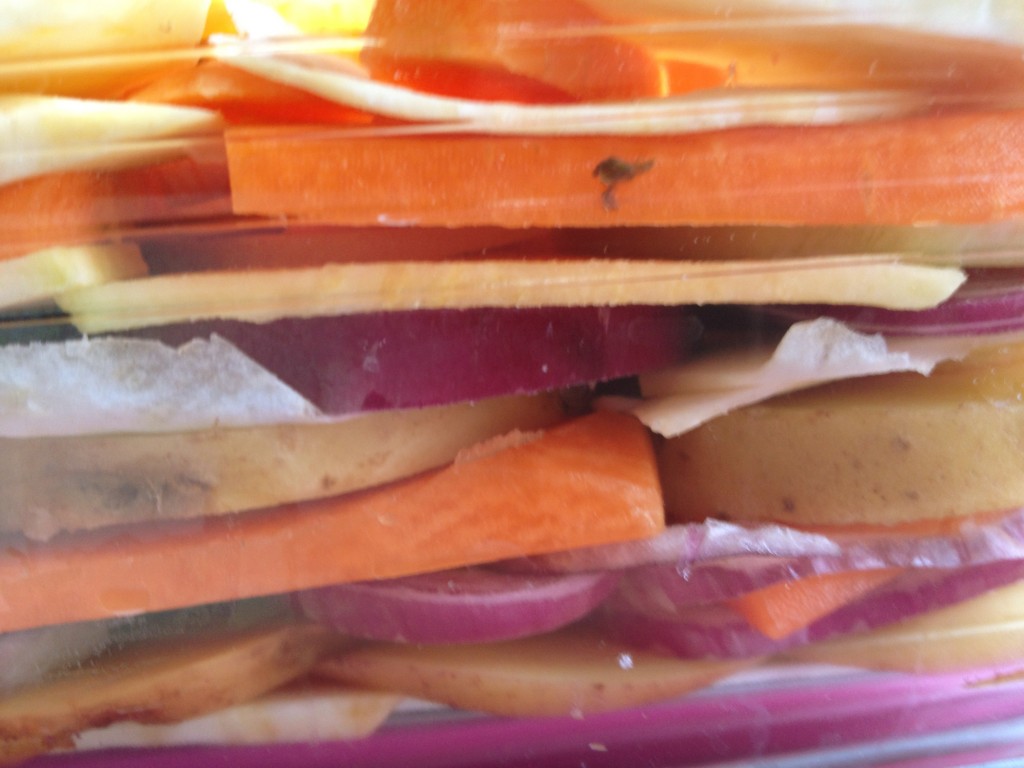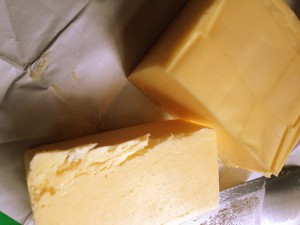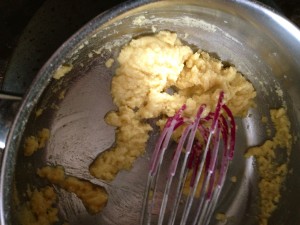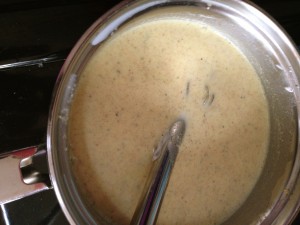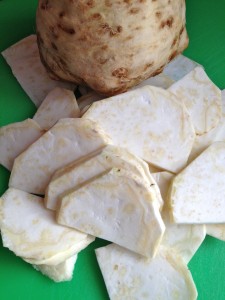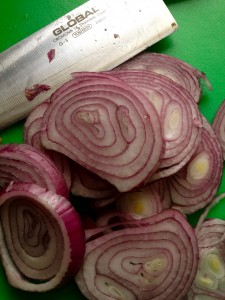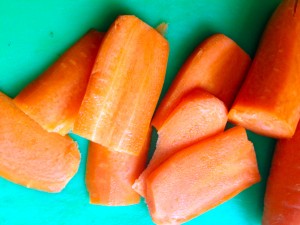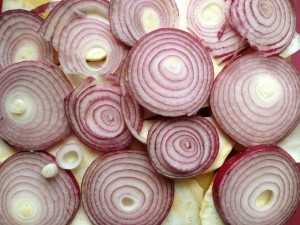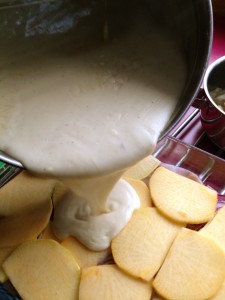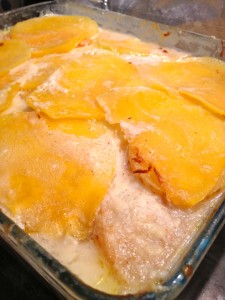Exactly as with the Woolton Pie, the initial decision as to whether you are going with a potato topping or a pie crust also determines the contents of the pie. Potatoes are the main focus of the decision making process as they will feature somewhere either mashed on the top or sliced in the filling. I like the idea of this being an actual pie (albeit a single crust so not really a proper pie) so I’m going with the pastry. The next decision is the vegetable content. The original mentions using the vegetables that are seasonal (if available) at the time, which we must do also. I’m making this in January so I’m going with potato, red onions (I was going to use leeks and wonder if I should?!? Argh, too late now – I didn’t buy any…but they are in season and very nutritious), swede, celeriac and carrot. Parsnip could be included (maybe instead of the celeriac?) but I’ve gone off them so I’m rejecting them. Parsnips, however, are an excellent source of fibre (maintains healthy bowels), folate (helps regenerate the body, make blood cells, fights against birth defects), vitamin K (builds strong bones, helps cells grow and live, helps blood clot), and potassium (regulates blood pressure and keeps the muscles and nerves functioning properly)…I still eschew them…
If you are going with the mash topping then bung the potatoes on to boil. I’m envisioning this as some kind of white sauce enveloped loveliness so I make the sauce first. The rationale being that after the semi-laborious job of slicing all the root vegetables, the layering of the dish will be simplified by adding sauce as I go. I’m aiming for a thick sauce this time so the option of pouring it on afterwards is less likely to achieve the desired coating as the sauce will be too thick to seep into every crevice. However, the proper version I should be making where the moisture is added to the dish by a broth, would work that way fabulously. If you fancy the brothier version (it is equally delish) then you’re actually making your life easier and less calorific…
I’m feeling a bit cavalier today so it’s out with the butter and on with the roux…
…then I come over all ‘béchamel sauce’ and add some nutmeg and pepper…
While that is simmering away to itself and the flour cooking off…I get slicing. The original recipe was diced and pre-cooked but I’m after something a little more showy. I imagine it as a beautiful, statuesque tower of root vegetables bound together with a suave, velvety sauce and positioned perfectly by the side of whatever it is accompanying…whatever!!
Then in a deep oven dish I layer the vegetables in a compact manner. Get them good a gussied up together.
The onions won’t hold their shape – they just won’t. They’re awkward beggars and like to twist and break apart once cooked through, so it’s a risk adding them at all and so I’m only putting a single layer into the middle.
As I mentioned earlier…layer and pour…if you’re using a thick sauce or it’ll just be an embarrassment later (voice of experience).
Then let the whole thing sit for a few minutes and give it the occasional jiggle, just to make sure everything is settled. Then cook it with a foil cover for about an hour (or more…dunno…) in a moderate heat. I like it to have a long, slow process as I believe (based on no fact whatsoever) that the flavours surrender into each other and make for a better result. The broth version cooks quicker and you can’t leave it for too long as the potato, especially, will disintegrate and then you’ll have a full scale onion and potato mutiny on your hands…and it won’t be pretty…
This is the point when I froze it. I shall report anon to how the quivering towers of accompaniment actually turn out…
This recipe is oh so adaptable. Leeks/onions (spring) in the mash or in the filling, seasonal combos galore, creamier sauce or drier stacked filling and so on…let your spirit and cooking soul guide you and create your very own version which you must instantly name and claim as yours…
The humble potato, the staple of millions of tables, has a fair bit to offer on the nutrition front so rethink your opinion and, more importantly, your cooking methods. First don’t believe everything you read about GI indexes and all that, because in truth, the results vary hugely depending on considerations like type, origin, the method of cooking, even the temperature they’re eaten at, all play a part in how it breaks down in your body. Complex carbs keep you fuller longer and release slower so you have sustained energy. Potatoes have vitamins (notably C – just under the skin), minerals, fibre and a handful of those handy phytochemicals (see below) we need. Celeriac (celery root but also called celery knob in some places?!?) is the most ignored root vegetable of them all surely? It is staggeringly low in calories as it has a low starch content, it has phosphorus (vital to cell function and regulates calcium for strong bones and teeth) and potassium (water balance, blood pressure management, nerve function), vitamin K and C (healthy cells, growth and repair of tissue, boosts the immune system and much more) and a nice hit of iron (transports oxygen, helps make red blood cells, fights fatigue of body and mind). Carrots are a fab source of beta-carotene. Beta-carotene has antioxidant properties that help prevent ageing damage to your cells, fights cardiovascular issues and the vitamin A that the liver creates from it keeps skin, hair and nails healthy, flushes out the liver and helps your retinas stay in tip top condition. Phew! The swede originated in Central Europe some say, while others go with Sweden obviously, and was originally just used to feed cattle. It has good food benefits for humans too! High in potassium and vitamins A, C , E and K and a great source of fibre.
Root vegetables rock!
Onions are high in phytochemicals/phytonutrients (non-nutritive plant compounds that aren’t used for sustaining life but rather for other aspects like protecting the plant, fighting diseases and also colour and scent. They are believed to have disease fighting properties for humans). The one often mentioned is quercetin which sweeps through the body removing harmful free radicals whilst simultaneously supporting the cardiovascular system, the immune system, promoting bone health and assisting with congestion and fighting mild allergies! Red onions (especially the outer layers) are packed with this and many other wonder compounds too. However, had I gone with leeks then they are chock full of vitamins, minerals and specifically folate and, like garlic and other alliums, antioxidants (notably allicin) – which does lots of wondrous things like help lower cholesterol and blood pressure. If that wasn’t enough, it also acts as a general anti-bacterial, anti-viral and anti-fungal…leeks are awesome! If you don’t like them then either learn to like them (don’t be so nesh!) or just chuck one under your pillow to have a vision of your future loved one. Hmmm…the wives tale says ‘husband’ but I can’t believe leeks are so sexist and wouldn’t also conjure up the vision of a future wife, partner, or whatever takes your fancy…after all it’s your vision…
